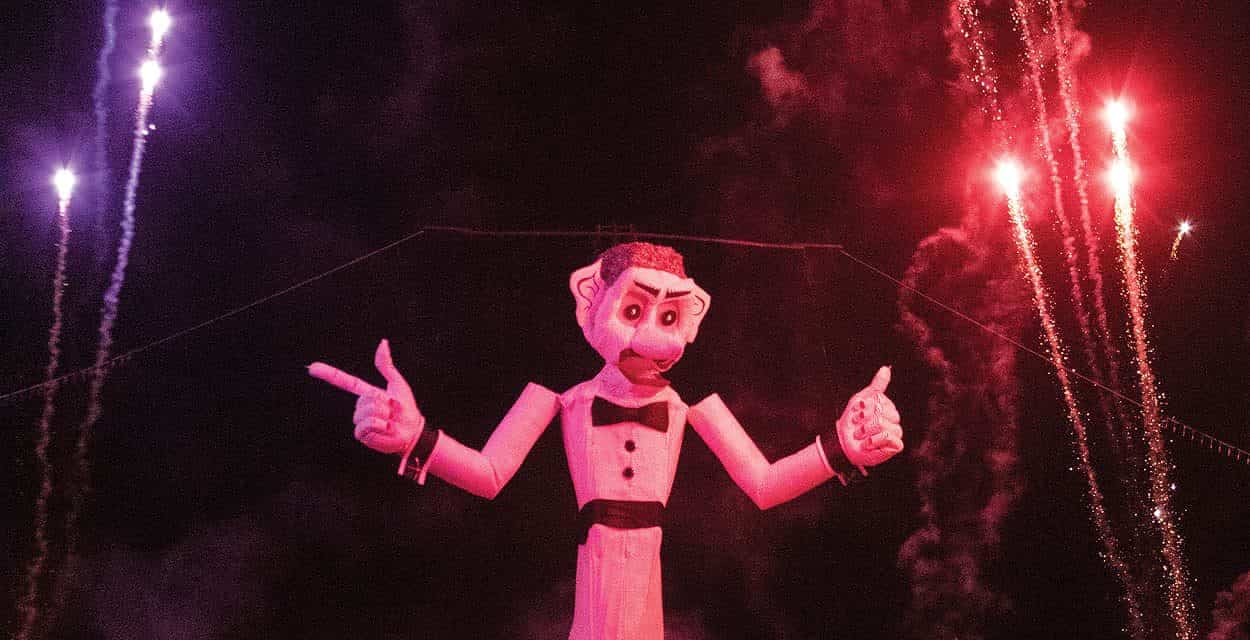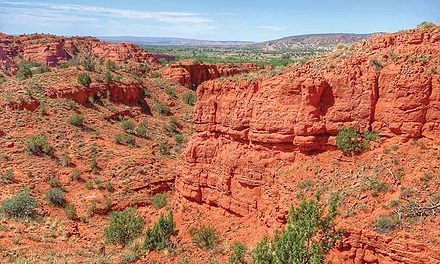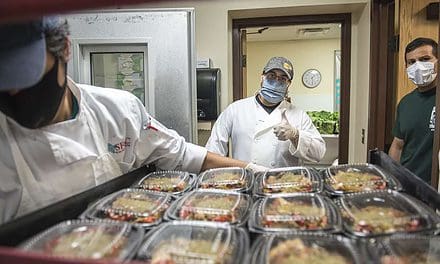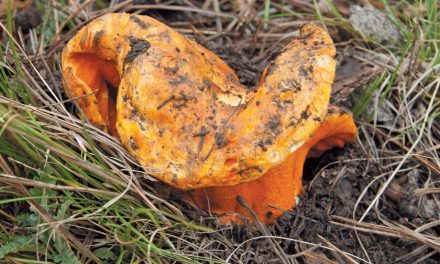By Briana Olson · Photos by Stephanie Cameron

In 1928, four years after the first burning of Zozobra, an American anthropologist observed “a peculiar scarecrow” crafted from camel vertebrae in a field south of Baghdad. He was there to collect grain samples excavated from the ancient city of Kish. Locals, he wrote, insisted that this at-once familiar and unfamiliar object increased yield not only by keeping birds away but through its magical properties. This was eleven years before the release of the Wizard of Oz, and the scarecrow had not yet acquired his dopey, cutesy status in popular culture. Small farms still dominated the American landscape, the scarecrow was—like the red-mouthed Zozobra—typically humanoid, and his purpose was ostensibly to frighten.
As any shit-splattered owl decoy can testify, birds are smart; they tend to disregard stationary, lifeless objects. In a survey of contemporary Polish farmers on why fewer and fewer scarecrows are used in the fields, one common answer was that they simply don’t work. (Another was the overall decrease in farming, due in part to the fragmentation of farmland.) Today’s tools include reflectors, digital distress calls, firearms, and drones like the RoBird, a robotic peregrine falcon that could serve as an antagonist in a Black Mirror episode. For an industrial farmer, the humble scarecrow might seem a symbolic, antiquated solution. The same might be said of the annual ritual of burning a giant ogre-puppet in Santa Fe’s Fort Marcy Park.
“I remember that Yaqui Village out of Tucson,” artist Will Shuster told an interviewer in 1964 about the event that most influenced his creation of Zozobra. “They carry a—of course, this came up from Mexico—a figure, it’s just like a scarecrow actually, stuffed with straw and fireworks and it represents Judas. They put him on a burro and lead him around the stations of the cross and then bring him back to the center of the plaza and ignite him.”
A tradition that passed from small-town Spain to Mexico, the Burning of Judas traditionally took place the day before Easter. The ritual burning was punishment for Judas’s supposed betrayal of Jesus. More broadly, Judas represented evil—doubt and disloyalty. From the start, Shuster and his Anglo collaborators recast the tradition as pagan, stripping any reference to the Catholic tradition, including the word evil itself.
It’s a long wait for those of us lucky enough to be present, In Real Life, at this year’s burning. The vast green lawn is mostly empty. No birds alight on Old Man Gloom, but at intervals a drone dances around him, zipping in and out like an irritating fly, capturing close-ups of his coronavirus crown and mad hornet cuff links for online viewing. The event is like a dress rehearsal crossed with the thing itself: there are starts and stops, mic checks, dancers in fringe practicing on the sidelines.
Against this quiet backdrop, I’m surprised by my shock when the lights go out at last. The puppet’s head, lit from within, is demonic. The torch bearers file out onto the platform, sinister and serious as they light boxes of something like grass, organic debris, as if to evoke the cathartic burning of the refuse of the season. Yet their performance unsettles me, the torches calling to mind medieval executions, women accused of witchcraft, twentieth-century lynchings. Are they striking at darkness, or reenacting it?
El quema de Judas, as practiced in Mexico, is no longer the show Shuster witnessed a century ago. Even in the nineteenth century, Mexicans used the event for political commentary often enough that governors banned representation of specific classes or individuals—and sometimes the burning itself. Over the course of the twentieth century, the tradition evolved to center the folk art of cartonería; the latest revival in Mexico City celebrates the preservation of this papier-maché sculpture-making.Disney figures, celebrities, el charro, and other loved—if contradictory—figures have joined the cast of los judas crafted by amateurs as well as professionals. Still, the devil and maligned figures (President Trump and his wall, for instance) predominate.
In the 1990s, Mexican philosopher Eli Bartra wrote that death, “the ultimate traitor,” had long been a popular figure among los judas. She noted the tradition’s presumed pre-Christian roots, its link to ancient rites of purification by fire.

As Shuster said, “this idea of destroying some unpleasant thing is . . . very, very old.” Shuster said his buddy Dana Johnson dug up the name zozobra from a Spanish dictionary. Technically, the word translates as insecurity or anxiety—the latter a condition that afflicted approximately forty million Americans even before the arrival of COVID-19. Farmers in particular have suffered from growing anxiety. With the consolidation of farmland over the past forty years, along with constant pressure to increase production and a precipitous rise in the cost of inputs, the risk of coming to ruin has long replaced starvation as the farmer’s most pervasive source of anxiety.
Maybe the invented quality of Zozobra, right down to his name, is part of his charm, and his endurance. Burning glooms sounds more profound than burning worries, and more plausible than burning away anxieties, whether collective or singular.
This year’s Zozobra wears red ping-pong balls in his silver hair, representing the spikes the virus uses to bind to human cells. The murder hornet cuff links speak as much to a widespread sense of disorder as to climate change and the plight of honeybees. Neither of these artistic flourishes is visible as he looms above the fire dancer, moaning like an old man. Hers is an impassioned, dangerous act, and she’s skilled and pleasing to watch. Yet I become briefly bored. The groaning is all too human, and I’m like the kid who sees through the magician’s tricks, the scarecrow nudging Dorothy to turn her attention to the man behind the curtain.
Then a fire blows out the side of Old Man Gloom’s mouth. His face is in flames. His body begins to go; his pointer finger shoots sparks. I’m exhilarated when his frame becomes visible within his burning limbs. The whole right side of his body blows off in a sheet of ash, tiny fragments of wood and paper that resemble burnt grass, flickering in the firelight. The frame falls, the groaning stops, the faces of people I’ve lost pass through my mind.
Finally, nothing is left of him but a burning woodpile, a gravesite.
Documentation of the practice is limited, but many say that farmers used to burn their scarecrows after the harvest. Perhaps they were burning their “glooms,” celebrating relief at the success of the crops. Perhaps, by burning straw men in time with the seasons, they were confronting their own mortality. The ancient Greeks carved wooden statues of Priapus, protector of wheat and vineyards, to use in their fields, suggesting that the scarecrow’s mystical function is not such an oddity. Maybe, too, the scarecrow décor that springs up during fall, from the smiling scarecrow dolls hung from front doors and fences to the eerie scarecrows of the haunted house, are not simply vestiges of the agrarian past, but protectors, markers of the cycle of life—urgent and ephemeral.
As for the supposed inefficiency of scarecrows, it’s worth remembering that birds, too, play more than one role on a farm. As much as birds may flock to apples and corn, they also devour cutworms, aphids, and locusts. For centuries, farmers have recognized avian diversity as a sign of farm health.
Edible celebrates New Mexico's food culture, season by season. We believe that knowing where our food comes from is a powerful thing. With our high-quality, aesthetically pleasing and informative publication, we inspire readers to support and celebrate the growers, producers, chefs, beverage and food artisans, and other food professionals in our community.












